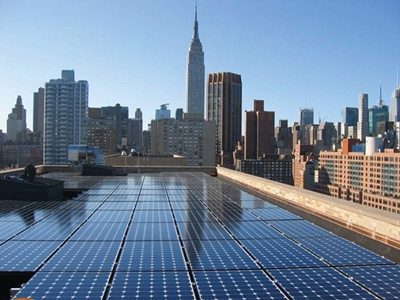The myth is that solar energy has achieved little despite huge subsidies. The reality is that solar has achieved a great deal despite relatively low subsidies.
A new report from the Baker Center for Public Policy just released a fabulous new analysis comparing incentives for solar with historical incentives for fossil fuels, including this chart:
 The report, commissioned by the solar industry’s trade group, has a number of interesting conclusions:
The report, commissioned by the solar industry’s trade group, has a number of interesting conclusions:
– Solar has had relatively small subsidies. That’s right, incentives for solar have been small compared to fossil fuels
– Incentives are working. Long term, stable incentives have ‘bridged the chasm’ to get solar past early adoption stages and to market.
– The employment potential for solar is even better than anticipated. Solar can create between 200,000 and 430,000 jobs in 2020.
– Solar power will not only be competitive, but will be a robust addition to America’s energy portfolio. Expanding the use of solar would limit the impact of price volatility and supply disruption- just rooftop solar could provide 20 percent of America’s energy needs.
These arguments are even more persuasive in light of the recent paper from McKinsey showing how dramatically the market for solar photovoltaics will grow in the coming decade. Taken together, these analyses show that we are clearly reaching the dawn of a new age for solar.
Let’s explore some of the most important takeaways from the Baker Center report:
Solar has not received a disproportionate amount of Federal Subsidies
Critics often claim that solar is unfairly subsidised. The Baker Center report squashes this claim with some nuanced analysis on the necessity and purpose of subsidies:
“Diffusion of solar energy technology in the energy markets is consistent with the less-than-smooth paths that many American industries have traveled as they entered the mainstream of commerce.”
No energy technology goes from laboratory to market overnight. As the report puts it, innovators and early adopters only constitute 16 percent of total technology adoption. Then there is a ‘chasm’ before mainstream adoption by the remaining 84 percent. What subsidies do, in bridging this chasm, is ensure that while “not all companies that enter the market early flourish … the industry itself can succeed.” Federal incentives have classically supported new energy resources during the average 30-year period between early adoption and full technology adoption.
The Baker Center found that “federal investment in solar technologies has been modest in a long-term historical context relative to other energy technologies.” As the above diagram shows, solar has not only received far less total subsidization, but it is receiving it at the point where technologies are supposed to be receiving support:
Incentives are working
How do we tell if incentives are working? The Baker Center rightly argues that the basic purpose of subsidization is to bring a technology across the “chasm” and into mainstream adoption. This being the case, the best policies are stable and long-term, giving investors strong policy signals that build confidence in the technology. As their findings show, the incredible growth rate in solar capacity over the last few years (see below) all took place while the federal investment tax credit and state renewable energy standards were in place. Tack on falling prices for PV, and you get a 77 percent growth rate in the period over the last five years. This growth is spurring more innovation in manufacturing and deployment, helping push solar PV toward grid parity at a rapid rate.
Growth in Solar PV will create jobs
Did I say jobs? I meant hundreds of thousands of jobs. The report finds that between 200,000 and 430,000 direct, indirect, and induced jobs will come from the solar industry in 2020. A recent solar jobs census found that there are already 100,000 Americans working in the sector. The connection is clear: more demand and lower costs are accelerating employment in the installation, maintenance and manufacturing of solar PV.
According to this report, solar gives you more bang for your buck — providing “more jobs per megawatt-hour than any other energy industry.”
There are also implications for global competitiveness. In 2010, the United States was a net exporter of solar PV to China, with a $1.9 billion trade surplus. If we can keep our stake in the global PV market, we will create an additional 67,000 jobs by 2030 through increased exports.
 Solar is a crucial component of the US energy portfolio
Solar is a crucial component of the US energy portfolio
Solar’s impact on the energy mix will depend on what kind of support the industry gets during this critical period. For the optimist, the report outlines a “Solar Grand Plan” projecting the technology could “provide 35 percent of total U.S needs by 2050 and 90 percent by 2100.” According to the below estimates, there are 3.9 million terawatt-hours of recoverable solar resources available through a combined set of compressed air storage and solar generation technologies.

The potential for solar is enormous in the US. But it’s not theoretical anymore. Solar PV is rapidly gaining market traction today — creating jobs, providing local economic value, and doing so with government support consistent with every other energy technology throughout history.
Adam James is a special assistant for energy policy at the Center for American Progress.
This article was originally published on Climate Progress – thinkprogress.org/climate/. Reproduced with permission.







